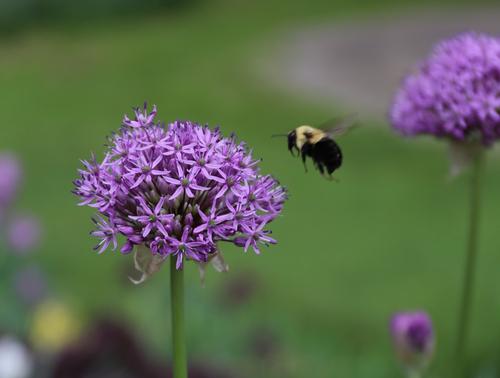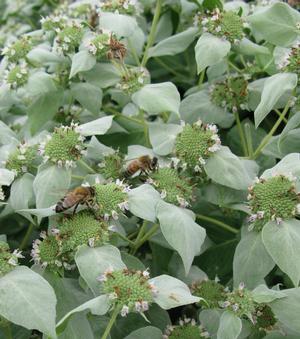Know Your Pollinators and What They Need
Home gardens can provide safe havens for wild and domestic bees. These pollinators need our help as they struggle to overcome habitat loss, pesticides, diseases and other environmental stresses.
WHO ARE THE POLLINATORS?
Thousands of different species are responsible for pollination. Many are uniquely adapted to pollinate certain types of plants, which makes protecting pollinator diversity extra important.
Honeybees are social bees and the only ones that live in hives and produce harvestable honey. They were introduced to North America from Europe almost 400 years ago. Honeybees are good pollinators and especially effective at pollinating fruits, vegetables and nuts.
Native bees are more efficient pollinators than honeybees. They work longer hours, tolerate harsher weather and pollinate a much wider range of flowering plants. In the U.S. there are more than 4000 species of native bees, including bumblebees, mason bees and leafcutter bees. Most species are solitary, but some form colonies. They typically nest and lay their eggs in the ground or in stems and sticks.
Other native pollinators include butterflies, moths, beetles, flies, hummingbirds and some species of bats.

WHAT DO POLLINATORS NEED TO SURVIVE?
FOOD. Pollination is a byproduct of feeding. Pollinators visit flowers to drink nectar or gather pollen. While they are feeding, pollen sticks to their bodies and is moved around on the flower. Some of it is carried onto the next flower they visit.
Gardeners can support pollinators by growing flowers that are rich in pollen and nectar. The list includes many garden favorites such as alliums, asters and poppies. Native plants should also be included because they attract and sustain a greater number and wider diversity of pollinators. Flowering weeds have been shown to attract 4 times more pollinators than domesticated plants.
Pollinators need access to pollen and nectar from early spring through late fall. Planting a diversity of trees, shrubs, perennials and annuals will ensure your yard provides a dependable supply of food from one season to the next.
Which plants are best? It depends where you live. The North American Pollinator Partnership Campaign offers free, region-specific guides tailored to 32 different areas in the U.S. and Canada.
SHELTER. The more varied your landscape, the more attractive it will be to pollinators. A yard with layers of trees, shrubs, perennials, annuals and ground covers provides many more shelter and nesting options than a half-acre of lawn.

If possible, allow a few areas in your yard to “go wild”. Some native bees use dead trees, dry twigs and hollow reeds for nesting. Bee nesting boxes, filled with bamboo, reeds, twigs and straw, can be safely located almost anywhere, since native bees only sting as a last resort. Consider leaving a few areas of bare soil or a pile of sand for ground-nesting bees.
WATER. Bees need reliable access to water. They will drink from almost any water source that gives them good footing so they don’t fall in. Good options include a birdbath or a small natural or artificial pond with floating water plants. Another idea is to fill a shallow tray or saucer with stones and just enough water to partially cover them. Bees land on the stones and are able to safely and easily reach the water.
OTHER BEE-FRIENDLY TIPS
• Bees and other pollinators prefer feeding from a group of the same type of plant. Groups of plants are easier for them to locate and also improve their foraging efficiency.
• Minimize your use of pesticides. Pesticides can kill beneficial insects along with harmful ones. Be sure to identify the problem first, so you can use the most targeted pest-specific remedy. Always follow labeling instructions carefully and spray at dawn or dusk before bees are active. Avoid spraying plants that are in full bloom.
• Avoid using herbicides. When applied alone or in combination with other chemicals, herbicides can pose a danger to bees. As with pesticides, always avoid spraying weeds when they are in bloom.
To learn more, read: How to Attract Butterflies to Your Garden


